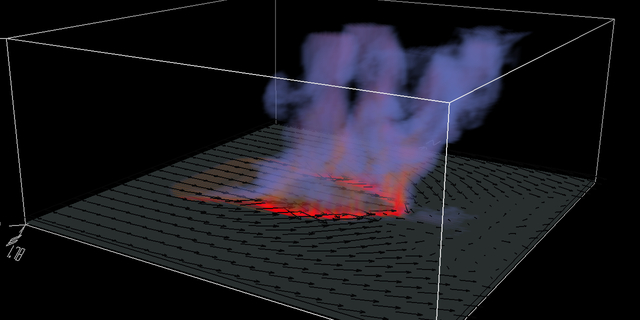Coupled Weather-Wildland Fire Modeling
Simulating Fundamental Aspects
of Wildland Fire Behavior
The following animations show coupled
weather-fire behavior model simulations of the growth of
wildfires. They were simulated using the CAWFE (TM) modeling system (Coupled
Atmosphere-Wildland Fire Environment).
The
widely-observed "universal fire shape" evolves from the
physics of fire interactions with the atmosphere.
The fire starts as a line; constant
easterly winds of 3 m/s are driving the fire from
behind. The fuel is "chaparral", a brush common in parts
of CA, AZ, and the central Rocky Mtns. Wildfire control
in chaparral (a species that has adapted itself to recurring
fires) is notoriously difficult, because coupling Santa
Ana winds, with droughts, long summers, and (often) steep
terrain, creates intense, rapidly spreading fires.
The misty field is smoke, denser and more red where the fire
is burning most intensely.
As the fire spreads, it evolves into a shape well-known to
fire managers, with three parts: 1) the "head" - the leading
edge of the fire where the heat is focussed, 2) two "flanks" -
along the side, here the winds blow basically parallel to the
edge of the fire, and 3) the "back" - the slowest moving part
of the fire that creeps against the wind. The heat from
the fire rises in updrafts(s) that the winds focus at the head
of the fire. These updrafts draw warm air into their
base from all directions, guiding the wind to flow along the
flanks and focus the heat at the front. In this way, the
interaction of the fire with environmental winds creates a
self-perpetuating, universal shape that is observed in fires
in many conditions all around the world.

Animation - click
here for .mp4 (3 Mb)
As the fire grows, perturbations (seen in
the next animation to be fire whirls) grow occur along the
fire flank, which are brought forward to the head, which gets
stronger (changing the airflow all around the fire, directing
some parts of the fireinto fresh fuel, creating some local
heat and more fire whirls, etc. This increase in intensity is
not due to the environment (which remains constant) or fuel
(the fuel is the same throughout the domain), but purely the
fire-induced winds.

Animation - click here for mp4
The simulations were visualized using Vis5D.
Keywords: wildfire models, fire behavior, forest fires, fire model, wildland fire model